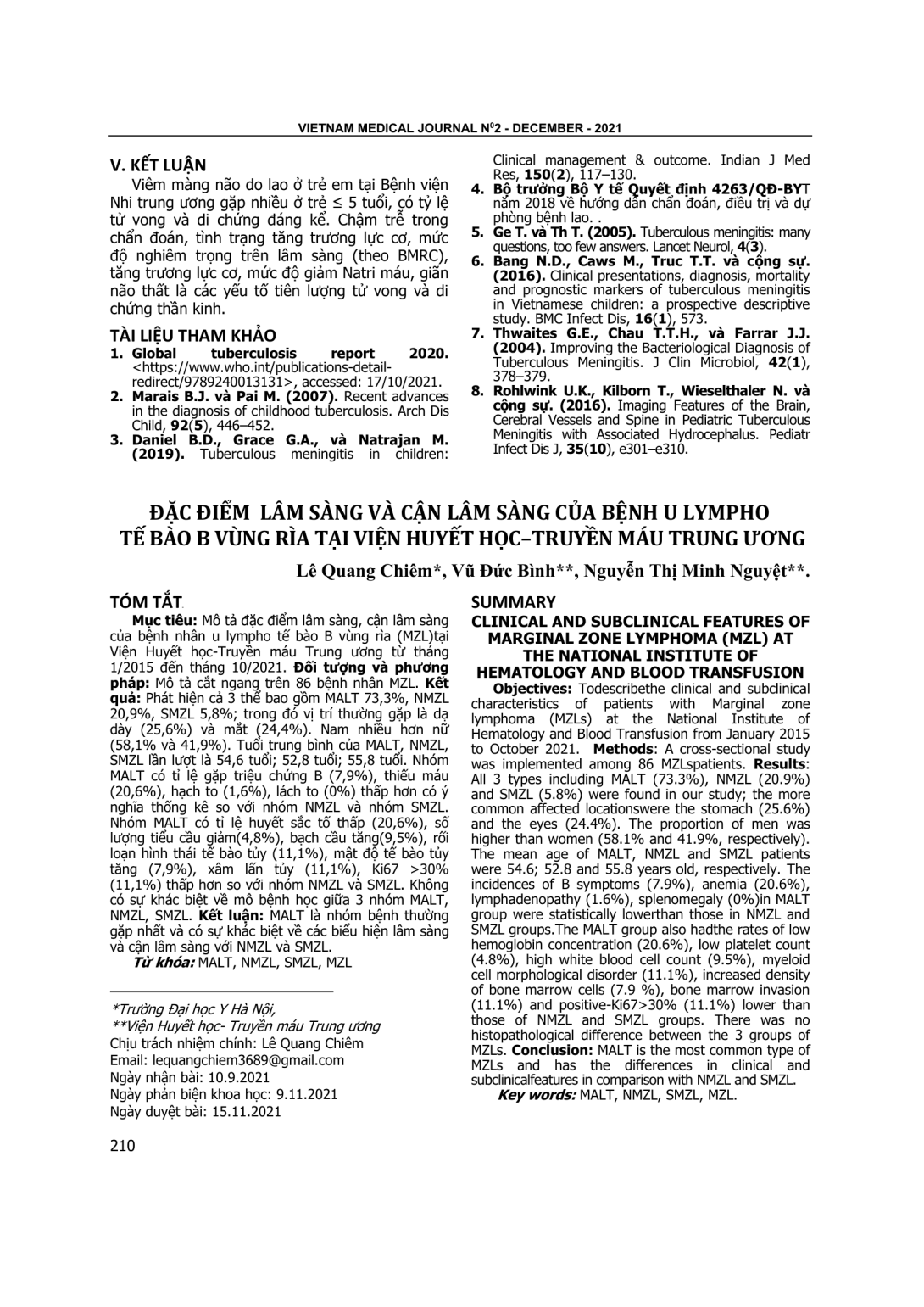
Mô tả đặc điểm lâm sàng, cận lâm sàng của bệnh nhân u lympho tế bào B vùng rìa (MZL)tại Viện Huyết học-Truyền máu Trung ương từ tháng 1/2015 đến tháng 10/2021. Đối tượng và phương pháp: Mô tả cắt ngang trên 86 bệnh nhân MZL. Kết quả: Phát hiện cả 3 thể bao gồm MALT 73,3%, NMZL 20,9%, SMZL 5,8%; trong đó vị trí thường gặp là dạ dày (25,6%) và mắt (24,4%). Nam nhiều hơn nữ (58,1% và 41,9%). Tuổi trung bình của MALT, NMZL, SMZL lần lượt là 54,6 tuổi; 52,8 tuổi; 55,8 tuổi. Nhóm MALT có tỉ lệ gặp triệu chứng B (7,9%), thiếu máu (20,6%), hạch to (1,6%), lách to (0%) thấp hơn có ý nghĩa thống kê so với nhóm NMZL và nhóm SMZL. Nhóm MALT có tỉ lệ huyết sắc tố thấp (20,6%), số lượng tiểu cầu giảm(4,8%), bạch cầu tăng(9,5%), rối loạn hình thái tế bào tủy (11,1%), mật độ tế bào tủy tăng (7,9%), xâm lấn tủy (11,1%), Ki67 >30% (11,1%) thấp hơn so với nhóm NMZL và SMZL. Không có sự khác biệt về mô bệnh học giữa 3 nhóm MALT, NMZL, SMZL. Kết luận: MALT là nhóm bệnh thường gặp nhất và có sự khác biệt về các biểu hiện lâm sàng và cận lâm sàng với NMZL và SMZL.
Todescribethe clinical and subclinical c-haracteristics of patients with Marginal zone lymphoma (MZLs) at the National Institute of Hematology and Blood Transfusion f-rom January 2015 to October 2021. Methods: A cross-sectional study was implemented among 86 MZLspatients. Results: All 3 types including MALT (73.3%), NMZL (20.9%) and SMZL (5.8%) were found in our study; the more common affected locationswere the stomach (25.6%) and the eyes (24.4%). The proportion of men was higher than women (58.1% and 41.9%, respectively). The mean age of MALT, NMZL and SMZL patients were 54.6; 52.8 and 55.8 years old, respectively. The incidences of B symptoms (7.9%), anemia (20.6%), lymphadenopathy (1.6%), splenomegaly (0%)in MALT group were statistically lowerthan those in NMZL and SMZL groups.The MALT group also hadthe rates of low hemoglobin concentration (20.6%), low platelet count (4.8%), high white blood cell count (9.5%), myeloid cell morphological disorder (11.1%), increased density of bone marrow cells (7.9 %), bone marrow invasion (11.1%) and positive-Ki67>30% (11.1%) lower than those of NMZL and SMZL groups. There was no histopathological difference between the 3 groups of MZLs. Conclusion: MALT is the most common type of MZLs and has the differences in clinical and subclinicalfeatures in comparison with NMZL and SMZL.
- Đăng nhập để gửi ý kiến
